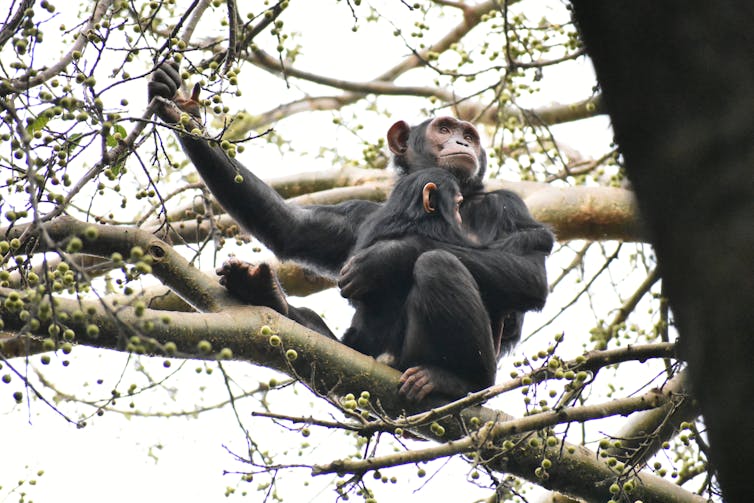Wild chimpanzees have been studied for more than 60 years, but they continue to delight and surprise observers, as we found during the summer of 2017 in Kibale National Park in Uganda.
We were observing young chimpanzees’ play to better understand how they grow up. For most group-living animals, play is an integral component of development. Beyond just having fun, social play allows them to practice critical physical and social skills they will need later in life.
But that summer, we realized that it wasn’t just the young ones playing. Adults were joining in on play more often than we had seen before, especially with each other. Watching fully grown female chimpanzees tickling each other and laughing surprised even the most veteran researchers of our project.
Two moms with babies play with one another on small trees, and two other young chimpanzees join in.
What made this so unusual was not that adult chimpanzees were playing at all, but that they were doing it so frequently. A behavior that we typically might see once every week or two became something that we saw every day and sometimes lasted for hours.
So what had changed that summer? For us, as primatologists, this is where the fun began.
Why would adults play in the first place?
Scientists tend to think the main reason play declines with age is that individuals essentially grow out of it as they master motor and social skills and shift toward more adult behaviors. By this logic, adults only rarely play because they no longer need to. The situation is different for domesticated species like dogs because the process of domestication itself preserves juvenile behaviors like playfulness into adulthood.
Neither of these reasons would explain why our adult chimpanzees were shoving babies out of the way to play with each other that summer. Instead of asking why adults would play, we had to ask what might, in other circumstances, stop them from playing. And for this, we had to go back to the basics of primatology and consider the effects of food on behavior.
The summer of 2017 was notable because there was an unusually high seasonal peak of a lipstick-red fruit called Uvariopsis, a favorite and calorie-rich chimpanzee food. During the months when these fruits are ripe and plentiful, chimpanzees spend more time hanging out together in larger groups.
This sort of energy surplus has been linked to rigorous activities, such as hunting among monkeys. We wondered whether fruit abundance might be linked to social play as well. Perhaps adult play is constrained because grown chimpanzees just don’t usually have the extra time and energy to devote to it.

Gathering enough food to eat is a critical daily task.
Kris Sabbi
When life gets in the way of play
To test this idea, we turned to the long-term records of the Kibale Chimpanzee Project, extracting nearly 4,000…



